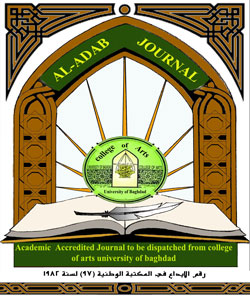Lenguaje y pensamiento
la función de la cognición entre el mundo árabe y el occidental (estudio comparativo)
DOI:
https://doi.org/10.31973/aj.v1i130.639Keywords:
Lenguaje, lengua, habla, pensamiento, cogniciónAbstract
En este trabajo abordamos el lenguaje según la teoría de la lingüística cognitiva. Esta corriente supone una revolución debido a la tesis de que el lenguaje es producto de materia mental y en su formación actúan varios procesos cognitivos. Esto implica que la manera en la que percibimos la experiencia del exterior sea algo muy significativo en la formación del lenguaje y uno de los rasgos más importantes de nuestra percepción es que está determinada por nuestras características corporales. Además, esta corriente entiende el lenguaje basado en su uso, porque considera que el significado que genera cada sujeto es único debido a que todos tenemos un conocimiento del mundo y un contexto particulares.
Downloads
References
AL-GALāYINī, Al-Šayj MuṢṭafā (2003). Ŷamʻa al-durūs al-ʻarabῑyyā, vol. I. Cairo.
AL-GAZZAR, Abu Bakr (2005). Diwan. Abu Bakr al-Gazzar, el poeta de la Aljafería (ed. Bilingüe, estudio introductorio y notas de Salvador Barberá Fraguas). Zaragoza: Larumbe-Prensas Universitarias de Zaragoza.
ARISTÓTELES. (1988). Acerca del alma. Edición presentada por María Riera García. Madrid: Gredos.
ASÍN PALACIOS, M. (1940). «Ibn al-Sīd de Badajoz y su “Libro de los cercos”». En la revista Al-Andalus, nº 5.
BARTHES, Roland (1971). Elementos de Semiología. Madrid: Talleres Gráficos Montaña.
BÜHLER, Karl (1967). Teoría del lenguaje. Madrid: Selecta de Revista de Occidente.
CHOMSKY, Noam (1979). Reflexiones sobre el lenguaje. Barcelona: Ariel.
CHOMSKY, Noam (1989). El conocimiento del lenguaje. Madrid: Alianza.
CIFUENTES HONRUBIA, J. L. (1996). Gramática cognitiva. Fundamentos críticos. Madrid: Eudema.
CORRIENTE F. (1974). Las Mu´allaqāt: antología y panorama de Arabia preislámica: traducción literal y completa de los siete poemas originales, anotada y comentada en los aspectos literario y histórico. Madrid: Instituto Hispano-Árabe de Cultura.
CORTÉS, Julio (traductor, 1991). Corán. Barcelona: Editorial Herder S. A.
COSERIU, Eugenio (1969). «Sistema, norma y habla». En Teoría del lenguaje y lingüística general, págs. 11-113. Madrid: Gredos.
CROFT, William y CRUSE, Alan (2008). Lingüística Cognitiva. Madrid: Ediciones Akal.
DALE, Philips S. (1992). Desarrollo del lenguaje: un enfoque psicolingüístico. México: Edit. Trillas.
DUBOIS, Jean y otros autores (1979). Diccionario de lingüística. Madrid: Alianza.
GARAGALZA, Luis (2003). «Filosofía y lenguaje en la obra de Wilhelm von Humboldt».En Revista Internacional de los Estudios Vascos, nº 48, vol.I, págs.237-248.
GARCÍA MIGUEL, José María (2001). Lengua árabe: resumen gramatical. Vigo: Editorial de la Universidad de Vigo.
HEIDEGGER, Martin (1990). De camino al habla. Barcelona: Ediciones del Serbal.
HIERRO S. PESCADOR, José (1980). Principios de filosofía del lenguaje, col. I. Madrid: Alianza.
JABBOURI, Shatha Ismaeel (2014). “Los adverbios delante y detrás según la teoría cognitiva”, En Revista, Tonos Digital.
JAKOBSON, Roman (1984). Ensayos de lingüística general. Barcelona: Ariel.
LANGACKER, R. W. (1987). Foundations of Cognitive Grammar, vol. I. Stanford: Stanford University Press.
LUCY, John A. (1993). Reflexive Language. Reported Speech and Metapragmatics. Cambridge: Cambridge University Press.
PEÑA MARTÍN, Salvador (2004). «El signo en la lingüística árabe medieval». En la revista Al-Andalus-Magreb, nº 11, págs. 131-181.
REAL ACADEMIA ESPAÑOLA (2001). Diccionario de la lengua española (22ª edición). Madrid: Espasa Calpe.
ROCA, Juan Manuel (1991). Luna de ciegos. Medellín: Universidad de Antioquía.
RODRÍGUEZ FUENTES, C. (1996). La sintaxis de los relacionantes supraoracionales. Madrid: Arco Libros.
SAMANIEGO, José y TÉLLEZ, Ana (1981). «Funciones del lenguaje». En Taller de letras. México.
SAUSSURE, Ferdinand de (1945). Curso de lingüística general. Prólogo y notas por Amado Alonso. Buenos Aires: Losada.
SERRANO RUANO, Delfina (2008). «La teología dialéctica (kañam) en el Occidente islámico a través de la Muqaddima y de la biografía de Ibn Jaldún». En Miradas españolas sobre Ibn Jaldún, José Luis Garrot y Juan Martos Quesada (eds.). Madrid: Ibersaf Editores.
TAYLOR, J. R. (1989). Linguistic Categorization. Oxford: Clarendon Press.
WAUGH, Patricia (1996). Modern Literary Theory: A Reader. Ed. Rice Philip and Patricia Waugh (3rd ed.). London: Arnold.
Downloads
Published
Issue
Section
License
Copyright and Licensing:
For all articles published in Al-Adab journal, copyright is retained by the authors. Articles are licensed under an open access Creative Commons CC BY 4.0 license, meaning that anyone may download and read the paper for free. In addition, the article may be reused and quoted provided that the original published version is cited. These conditions allow for maximum use and exposure of the work.
Reproducing Published Material from other Publishers: It is absolutely essential that authors obtain permission to reproduce any published material (figures, schemes, tables or any extract of a text) which does not fall into the public domain, or for which they do not hold the copyright. Permission should be requested by the authors from the copyrightholder (usually the Publisher, please refer to the imprint of the individual publications to identify the copyrightholder).
Permission is required for: Your own works published by other Publishers and for which you did not retain copyright.
Substantial extracts from anyones' works or a series of works.
Use of Tables, Graphs, Charts, Schemes and Artworks if they are unaltered or slightly modified.
Photographs for which you do not hold copyright.
Permission is not required for: Reconstruction of your own table with data already published elsewhere. Please notice that in this case you must cite the source of the data in the form of either "Data from..." or "Adapted from...".
Reasonably short quotes are considered fair use and therefore do not require permission.
Graphs, Charts, Schemes and Artworks that are completely redrawn by the authors and significantly changed beyond recognition do not require permission.
Obtaining Permission
In order to avoid unnecessary delays in the publication process, you should start obtaining permissions as early as possible. If in any doubt about the copyright, apply for permission. Al-Adab Journal cannot publish material from other publications without permission.
The copyright holder may give you instructions on the form of acknowledgement to be followed; otherwise follow the style: "Reproduced with permission from [author], [book/journal title]; published by [publisher], [year].' at the end of the caption of the Table, Figure or Scheme.











